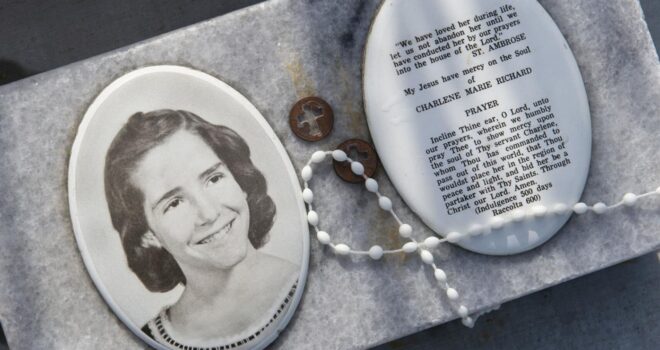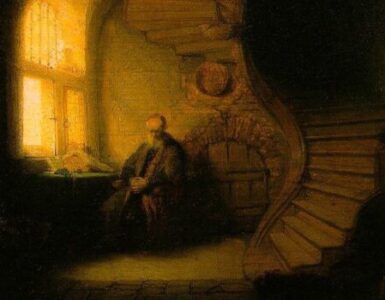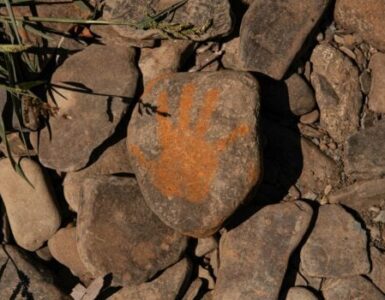Charlene Marie Richard was an ordinary Cajun country girl living in southeast Louisiana in the 1950s. Yet there is a seeming incongruity between her young life, fully immersed in the American culture of the era, and her single-mindedness to become a saint. This is the marvel of Charlene, who was so full of life and who cherished people so much.
Charlene loved sports, especially girls’ basketball. (She was captain of her team.) She loved baseball and horseback riding, too. But Charlene was deeply committed to Our Lady. She prayed her Rosary nightly, which she kept on her bedside table along with the Bible. The New York Times described the girl as “exuberant, loyal and generous.” The more one learns about the little Cajun saint, the more one can see the unity between the human and interior dimensions—and how this integrated life serves as an open catechism, a handy manual, of living the Catholic faith.
Mary Alice and Joseph Elvin Richard were the parents of ten children, and Charlene was the second oldest. Although the family did not have electricity, they kept a tidy home. As was common in Cajun culture, the boys served Mass as altar servers, and the girls sang in the choir. The family would attend Mass three times a week, in addition to Sunday. Charlene liked to put on plays for her family and often had her brother, John Dale, in the role of the priest.
Charlene had a strange set of encounters in her youth. A woman dressed in black with a black bonnet covering her face blocked her path twice. John Dale was with her one of these times, but he but did not see the figure himself. Nevertheless, since Charlene was known to be honest, people believed her account. Charlene addressed the woman in black as she blocked her pathway: “What in the name of God do you want?” The figure then disappeared under an old tree.
It was after this unusual encounter that specialists were brought in. Charlene experienced uncharacteristic nose bleeds and other blood loss that could not be explained.
They diagnosed Charlene with acute lymphocytic leukemia at the tender age of twelve. The doctors gave her just a couple of weeks to live. Devastated by the news, her parents felt it would be best if the hospital chaplain told Charlene the diagnosis.
Fr. Brennan, a young priest at the time, pondered how to break the news of impending death to little Charlene. He decided to explain the basics of redemptive suffering. So, he compassionately taught that her suffering could be united with Jesus’ sufferings and offered for the good of others. From that day until her last, Charlene would ask the priest, “Who shall I offer up my sufferings for today?”
Fr. Brennan and Sr. Crowley, OSF, the head of Pediatrics, witnessed the girl’s saintly growth in her short time in the hospital. Both testified that young Charlene accepted her painful sufferings and never complained. They also gave testimony that those for whom Charlene suffered and prayed experienced either healings or conversions.
The pains of little Charlene were so intense at times that her eyes would roll back in her head. But the sufferings of this great soul were winning victories for God. She wanted to be a saint and thus took full advantage of the saint-forming opportunities presented to her.
As the end neared, to comfort her, Fr. Brennan told Charlene that a beautiful lady was going to come and take her home. Charlene replied, “When the Blessed Mother comes, I will tell her that Father says ‘hello.’” Charlene Marie died shortly after.
At a commemorative Mass in Charlene’s honor, Fr. Brennan said, “Charlene taught us lessons in humility, acceptance, simplicity, and faith. We have many books teaching us how to live. Charlene wrote the book on how to die.”
The Bishops of the U.S. have affirmed that Charlene Marie Richard’s cause for canonization can go forward. The Diocese of Lafayette has one thousand six hundred testimonials of miracles from the intercession of the little Cajun saint. Ten thousand people visit her grave site each year.
One healing attributed to the little Cajun saint is the case of a Down Syndrome child. The Miraculous Life and Afterlife of Charlene Richard by Nathaniel Rich and Stacy Kranitz cites: “In 1987 Jean Marcantel was diagnosed with a high risk pregnancy and arranged to give birth at a hospital in Lake Charles where she could be attended by a prominent obstetrician.”
In the delivery room, the obstetrician said that the baby was a “mongoloid child,” to use the outdated term. He pointed out the common features of Down Syndrome to the other members of the medical team. Jean was brought to the recovery area. Here the mother prayed for the strength to raise a Down Syndrome child. Although Jean did not believe in miracles, she prayed to the patron saint of lost causes, St. Jude, and to little Charlene Richard for the miracle of a healthy child.
When Jean awoke, she saw her pediatrician confused. He said that the baby no longer showed any signs of Down Syndrome. Her child was brought in, perfectly healthy and happy. Jean did not leave her baby’s side for weeks, concerned that there might be a reversal of the condition. Today that baby—named Angelique—is a nun in Tanzania.
People from many different places are discovering the power of little Cajun saint’s intercession and learning that her life is a catechism indeed.
Saint Charlene Richard, pray for us!
Author’s Note: To learn more about Charlene or to submit a prayer request, contact the Charlene Richard Foundation.
Photo by Brad Bowie on Acadiana Advocate













